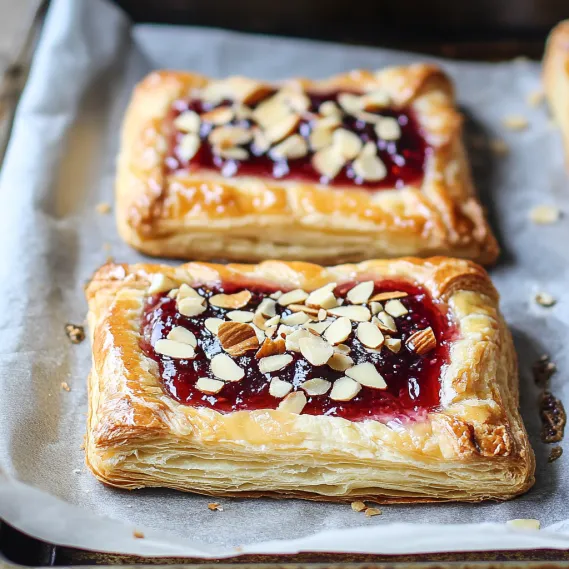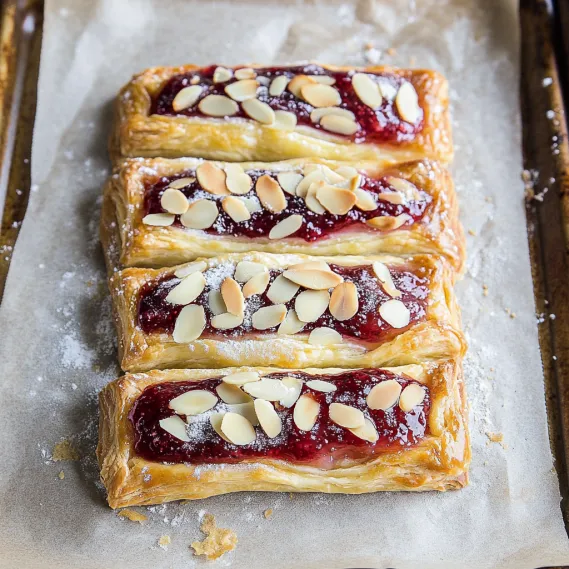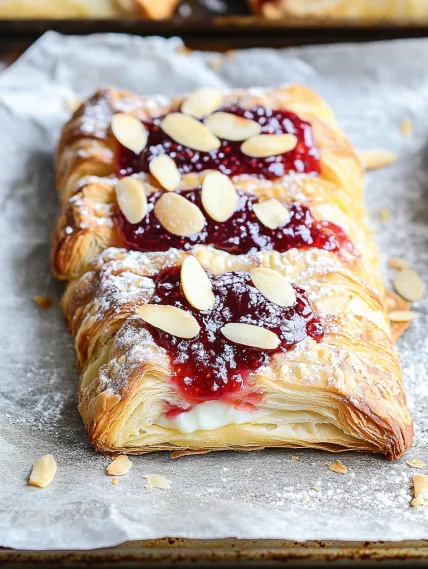 Pin it
Pin it
This raspberry almond puff pastry Danish delivers bakery-quality results with minimal effort. The combination of flaky pastry, creamy almond filling, and sweet-tart raspberry preserves creates a gorgeous breakfast treat that looks like you spent hours in the kitchen.
I first made these Danish pastries for a holiday morning breakfast and was amazed at how quickly they disappeared. My family now requests them for every special occasion, and guests always assume I've spent hours perfecting my Danish pastry technique.
Ingredients
- Frozen puff pastry: Thawed but still cold for the flakiest results
- Cream cheese: At room temperature to ensure a silky smooth filling without lumps
- Raspberry jam or preserves: With chunks of real fruit for authentic flavor and texture
- Almond extract: In both the filling and glaze to enhance the sophisticated flavor profile
- Sliced almonds: Lightly toasted to bring out their nutty aroma and provide textural contrast
- All-purpose flour: To stabilize the cream cheese filling so it bakes beautifully
- Lemon juice: To add brightness that balances the rich cream cheese base
Step-by-Step Instructions
- Prepare the Cream Cheese Filling:
- Start by whisking the egg until completely smooth, then incorporate flour, sugar, and salt. The flour creates stability while the sugar provides just enough sweetness. Add lemon juice and almond extract before whisking in room temperature cream cheese until perfectly smooth. Take your time with this step as a smooth filling makes a tremendous difference in the final product.
- Prepare the Puff Pastry:
- Carefully unfold your thawed puff pastry onto parchment paper and gently roll to smooth out any creases. Handling the pastry with light fingers prevents compressing the delicate layers that create the signature flakiness. Cut into two even rectangles and score a border around each one to create that beautiful risen edge that frames the filling.
- Initial Bake:
- Brush the edges lightly with milk which helps achieve that gorgeous golden color. The initial 15-minute bake allows the pastry to puff dramatically before adding the filling. This critical step ensures a properly layered base that can support the weight of the fillings while maintaining its delicate texture.
- Add Fillings and Complete Baking:
- Press down the center portion gently to create a well for your fillings. Spread the cream cheese mixture evenly across each pastry before dolloping raspberry preserves on top. The second bake sets the filling while further crisping the pastry edges. Tenting with foil during part of the baking prevents excessive browning while ensuring everything cooks properly.
- Glaze and Finish:
- Allow the pastries to cool completely before adding the simple almond glaze. Drizzle generously over the tops and immediately sprinkle with toasted almonds so they adhere to the glaze. Let the glaze set fully before slicing to achieve clean, bakery-worthy portions.
 Pin it
Pin it
My favorite part of this recipe is the moment the almond extract hits the warm pastry. The aroma takes me back to my grandmother's kitchen where she would make special breakfast treats for Sunday mornings. Though her Danish were made completely from scratch over many hours, this shortcut version captures that same magical feeling with significantly less effort.
Make-Ahead Options
These Danish pastries can be partially prepared ahead of time to make morning baking even simpler. Prepare the cream cheese filling up to two days in advance and store it covered in the refrigerator. Just bring it to room temperature for about 30 minutes before using so it spreads easily. The complete unbaked pastries can also be assembled the night before and refrigerated covered with plastic wrap, then baked fresh in the morning for a warm, impressive breakfast with minimal morning effort.
 Pin it
Pin it
Perfect Pairings
Serve these Danish pastries alongside a strong cup of coffee to balance the sweetness. For a complete brunch spread, pair with savory egg dishes like a simple herb frittata or scrambled eggs with chives. The contrast between the sweet Danish and savory eggs creates a well-rounded meal. For special occasions, accompany with a mimosa or bellini to transform breakfast into a celebration.
Flavor Variations
While raspberry creates a classic flavor profile, you can easily customize these Danish pastries with different fruit preserves. Apricot jam provides a delicious tangy sweetness, while blackberry or blueberry preserves offer deeper, more complex berry notes. For a winter version, try orange marmalade with a sprinkle of candied orange peel instead of almonds. You can also substitute vanilla extract for the almond if you prefer a more subtle flavor, though the almond truly makes these Danish special.
Storage Tips
These Danish pastries are best enjoyed the day they are made, when the pastry is at its flakiest. If you need to store leftovers, keep them in an airtight container at room temperature for up to two days. They can be gently reheated in a 300°F oven for 5-7 minutes to restore some crispness to the pastry. Avoid refrigerating the baked Danish as this can make the pastry soggy.
Frequently Asked Questions
- → How do I keep the puff pastry flaky?
Ensure the puff pastry stays cold while working with it. If it begins to warm, return it to the refrigerator to chill before baking for the best flaky result.
- → Can I use fresh raspberries instead of jam?
Yes, you can use fresh raspberries. Mix them with a little sugar and cook them down slightly to create a jam-like consistency.
- → What’s the best way to toast the almonds?
Toast the sliced almonds in a dry pan over medium heat for a few minutes, shaking occasionally, until golden and fragrant.
- → Can I prepare this dish ahead of time?
It’s best to serve the pastry fresh for maximum flakiness, but you can prepare the filling and assemble it in advance. Bake just before serving.
- → What alternatives can I use for almond extract?
You can substitute vanilla extract if you don’t have almond extract, though the flavor profile may differ slightly.
- → How do I prevent the edges of the pastry from burning?
If the edges brown too quickly, tent the pastry loosely with foil during baking to protect them from overcooking.
